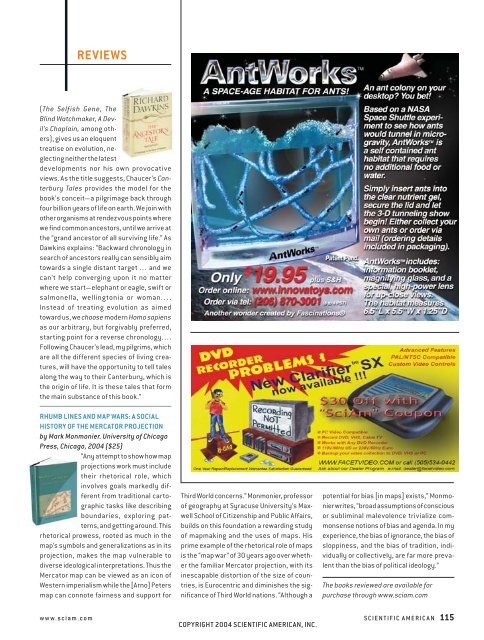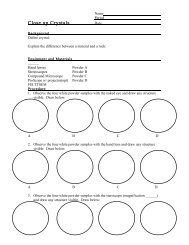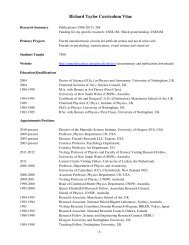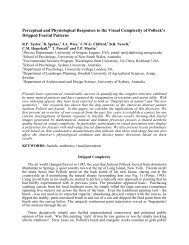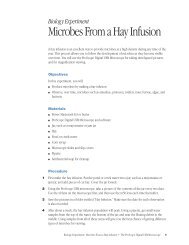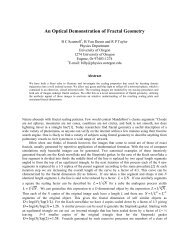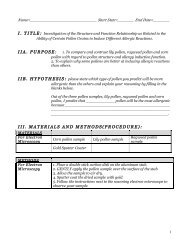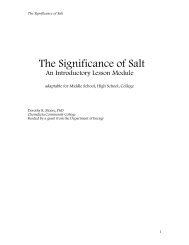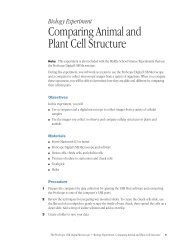December 2004 - Materials Science Institute - University of Oregon
December 2004 - Materials Science Institute - University of Oregon
December 2004 - Materials Science Institute - University of Oregon
You also want an ePaper? Increase the reach of your titles
YUMPU automatically turns print PDFs into web optimized ePapers that Google loves.
REVIEWS<br />
(The Selfish Gene, The<br />
Blind Watchmaker, A Devil’s<br />
Chaplain, among others),<br />
gives us an eloquent<br />
treatise on evolution, neglecting<br />
neither the latest<br />
developments nor his own provocative<br />
views. As the title suggests, Chaucer’s Canterbury<br />
Tales provides the model for the<br />
book’s conceit—a pilgrimage back through<br />
four billion years <strong>of</strong> life on earth. We join with<br />
other organisms at rendezvous points where<br />
we fi nd common ancestors, until we arrive at<br />
the “grand ancestor <strong>of</strong> all surviving life.” As<br />
Dawkins explains: “Backward chronology in<br />
search <strong>of</strong> ancestors really can sensibly aim<br />
towards a single distant target . . . and we<br />
can’t help converging upon it no matter<br />
where we start—elephant or eagle, swift or<br />
salmonella, wellingtonia or woman....<br />
Instead <strong>of</strong> treating evolution as aimed<br />
toward us, we choose modern Homo sapiens<br />
as our arbitrary, but forgivably preferred,<br />
starting point for a reverse chronology....<br />
Following Chaucer’s lead, my pilgrims, which<br />
are all the different species <strong>of</strong> living creatures,<br />
will have the opportunity to tell tales<br />
along the way to their Canterbury, which is<br />
the origin <strong>of</strong> life. It is these tales that form<br />
the main substance <strong>of</strong> this book.”<br />
RHUMB LINES AND MAP WARS: A SOCIAL<br />
HISTORY OF THE MERCATOR PROJECTION<br />
by Mark Monmonier. <strong>University</strong> <strong>of</strong> Chicago<br />
Press, Chicago, <strong>2004</strong> ($25)<br />
“Any attempt to show how map<br />
projections work must include<br />
their rhetorical role, which<br />
involves goals markedly different<br />
from traditional cartographic<br />
tasks like describing<br />
boundaries, exploring patterns,<br />
and getting around. This<br />
rhetorical prowess, rooted as much in the<br />
map’s symbols and generalizations as in its<br />
projection, makes the map vulnerable to<br />
diverse ideological interpretations. Thus the<br />
Mercator map can be viewed as an icon <strong>of</strong><br />
Western imperialism while the [Arno] Peters<br />
map can connote fairness and support for<br />
Third World concerns.” Monmonier, pr<strong>of</strong>essor<br />
<strong>of</strong> geography at Syracuse <strong>University</strong>’s Maxwell<br />
School <strong>of</strong> Citizenship and Public Affairs,<br />
builds on this foundation a rewarding study<br />
<strong>of</strong> mapmaking and the uses <strong>of</strong> maps. His<br />
prime example <strong>of</strong> the rhetorical role <strong>of</strong> maps<br />
is the “map war” <strong>of</strong> 30 years ago over whether<br />
the familiar Mercator projection, with its<br />
inescapable distortion <strong>of</strong> the size <strong>of</strong> countries,<br />
is Eurocentric and diminishes the signifi<br />
cance <strong>of</strong> Third World nations. “Although a<br />
potential for bias [in maps] exists,” Monmonier<br />
writes, “broad assumptions <strong>of</strong> conscious<br />
or subliminal malevolence trivialize commonsense<br />
notions <strong>of</strong> bias and agenda. In my<br />
experience, the bias <strong>of</strong> ignorance, the bias <strong>of</strong><br />
sloppiness, and the bias <strong>of</strong> tradition, individually<br />
or collectively, are far more prevalent<br />
than the bias <strong>of</strong> political ideology.”<br />
The books reviewed are available for<br />
purchase through www.sciam.com<br />
www.sciam.com SCIENTIFIC AMERICAN 115<br />
COPYRIGHT <strong>2004</strong> SCIENTIFIC AMERICAN, INC.


